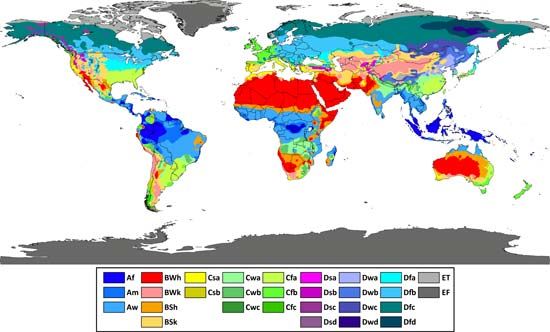World distribution of major climatic types
Our editors will review what you’ve submitted and determine whether to revise the article.
- Open Washington Pressbooks - SFCC Weather and Climate - Koppen Climate Zones
- Salt Lake Community College Pressbooks - Köppen Classification System
- Science On a Sphere - Koppen-Geiger Climate Changes -1901-2100
- Oregon State University Pressbooks - Permaculture Design: Tools for Climate Resilience - Koppen Geiger Classification Descriptions
- Nature - Scientific Data - Present and future Köppen-Geiger climate classification maps at 1-km resolution
- Mustansiriyah University - Climate classification
- BCcampus Open Publishing - Köppen Climate Classification System
- Key People:
- Wladimir Köppen
The following discussion of the climates of the world is based on groupings of Köppen’s climatic types. It should be noted that the highland climate (H) is also included here.
Type A climates
Köppen’s A climates are found in a nearly unbroken belt around the Earth at low latitudes, mostly within 15° N and S. Their location within a region in which available net solar radiation is large and relatively constant from month to month ensures both high temperatures (generally in excess of 18 °C [64 °F]) and a virtual absence of thermal seasons. Typically, the temperature difference between day and night is greater than that between the warmest and the coolest month, the opposite of the situation in mid-latitudes. The terms winter and summer have little meaning, but in many locations annual rhythm is provided by the occurrence of wet and dry seasons. Type A climates are controlled mainly by the seasonal fluctuations of the trade winds, the intertropical convergence zone (ITCZ), and the Asian monsoon. Köppen specifies three A climates:
Type B climates
Arid and semiarid climates cover about a quarter of Earth’s land surface, mostly between 50° N and 50° S, but they are mainly found in the 15–30° latitude belt in both hemispheres. They exhibit low precipitation, great variability in precipitation from year to year, low relative humidity, high evaporation rates (when water is available), clear skies, and intense solar radiation. Köppen’s classification recognizes three B climates:
- Tropical and subtropical desert climate (BWh, part of BWk)
- Tropical and subtropical steppe climate (BSk, part of BWk)
Type C and D climates
Through a major portion of the middle and high latitudes (mostly from 25° to 70° N and S) lies a group of climates classified within the Köppen scheme as C and D types. Most of these regions lie beneath the upper-level, mid-latitude westerlies throughout the year, and it is in the seasonal variations in location and intensity of these winds and their associated features that the explanation of their climatic character must be sought. During summer, the polar front and its jet stream move poleward, and air masses of tropical origin are able to extend to high latitudes. During winter, as the circulation moves equatorward, tropical air retreats and cold polar outbreaks influence weather, even within the subtropical zone. The relative frequency of these air masses of different origins varies gradually from low to high latitude and is largely responsible for the observed temperature change across the belt (which is most marked in winter). The air masses interact in the frontal systems commonly found embedded within the traveling cyclones that lie beneath the polar-front jet stream. Ascent induced by convergence into these low-pressure cells and by uplift at fronts induces precipitation, the main location of which shifts with the seasonal circulation cycle. Other important sources of precipitation are convection, mainly in tropical air, and forced uplift at mountain barriers. Monsoon effects modify this general pattern, while the subtropical anticyclone plays a role in the explanation of climate on the western sides of the continents in the subtropics. Köppen’s classification identifies six C climates and eight D climates:
- Humid subtropical climate (Cfa, Cwa)
- Mediterranean climate (Csa, Csb)
- Marine west coast climate (Cfb, Cfc)
- Humid continental climate (Dfa, Dfb, Dwa, Dwb)
- Continental subarctic climate (Dfc, Dfd, Dwc, Dwd)
Type E and H climates
Köppen’s type E climates are controlled by the polar and arctic air masses of high latitudes (60° N and S and higher). These climates are characterized by low temperatures and precipitation and by a surprisingly great diversity of subtypes. In contrast, type H climate contains all highland areas not easily categorized by other climate types. Although this category was not part of Köppen’s original system, some later climate systems include it as part of Köppen’s climate classification. Köppen’s two E climates and the H climate are listed below:
- Tundra climate (ET)
- Snow and ice climate (EF)
- Highland climate (H)














